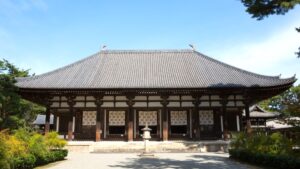Wakayama Castle, A Great Lord, Yorinobu, laid the foundation of the Kishu's prosperity
In 1619, three years after Tokugawa Ieyasu's passing, his 10th son, Tokugawa Yorinobu (1602-1671, 徳川頼宣), received 555,000 koku, equivalent to the rice crop of yield (*) and established the Kishu domain (present-day Wakayama and southern Mie Prefectures). Wakayama Castle, the Kishu Tokugawa Family's residence, was extended and constructed at the mouth of the Kino River, which flows into the Kii Channel, at a strategic point for water transportation. The three-story castle tower was designated a National Treasure in 1935 (presently a restored castle tower). The Nishinomaru Garden is the Chisenkaiyu-style (path around a pond) magnificently, featuring a waterfall and stone arrangements that capitalize on the steep slope of Mt. Torafusu. Another highlight is the corridor bridge, renowned as one of Japan’s most exquisite, adorned with serrated floorboards connecting the Nishinomaru and Ninomaru inner halls.
(*) 1 koku weighs about 150 kg of rice.


Filled with anti-authorities and difficult to govern
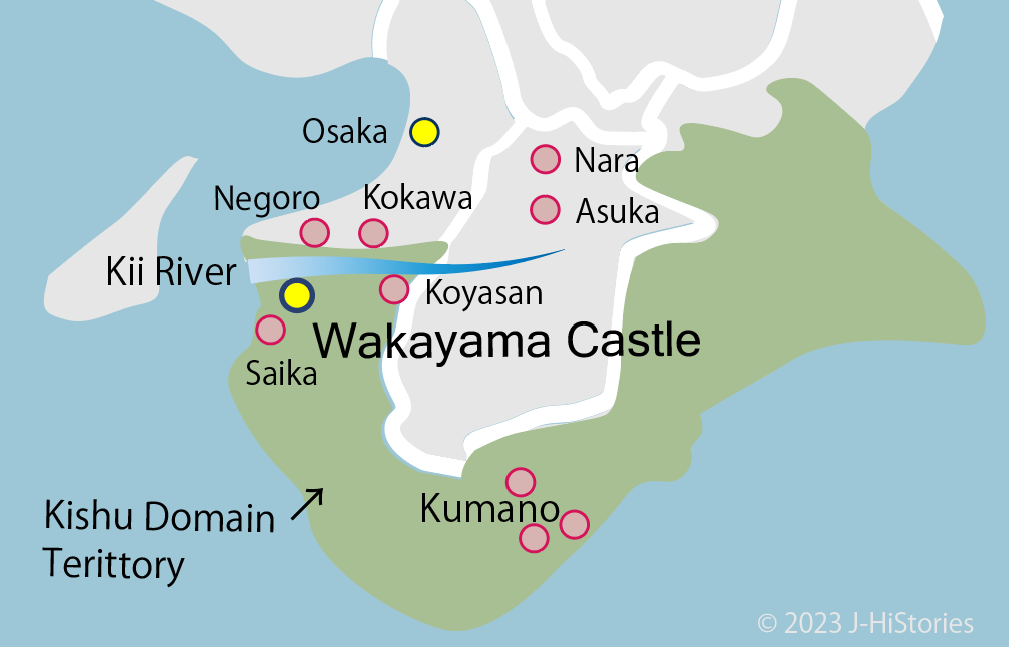
The Kishu domain was difficult to rule when he received it. The Negoro-shu (a faction of warrior monks from Negoroji Temple), the Saika-shu (a group of warrior followers of Honganji Temple), the Koyasan Temple, the Three Kumano Shrines, and Kokawa Temple, all had considerable autonomy with substantial economic and military influence within their respective regions. As a result, the Kii region was called "a large republic" by Luis Frois, a Portuguese missionary.
The Negoro-shu and Saika-shu emerged as the most formidable groups of gun mercenaries during the Warring States period (1467-1590), serving as gunmen for prominent warlords like Oda Nobunaga and Toyotomi Hideyoshi. The Negoro-shu boasted 10,000 members, while the Saika-shu comprised an arsenal of 8,000 guns. Their prominence became nationally recognized during the decade-long Ishiyama Battle between Oda Nobunaga and Osaka Honganji Temple. In 1576, the Saika-shu, armed with thousands of guns, resisted Nobunaga’s forces, leading to Nobunaga sustaining a leg injury from a bullet. Additionally, in a naval battle at the mouth of the Kizu River, the combined naval might of the anti-Nobunaga, Mori Clan and Saika-shu, defeated Nobunaga's fleet. Ultimately, Nobunaga managed to quell the Saika-shu with the assistance of the Negoro-shu. During that era, they stood out as the most potent gun-wielding faction.
Heading up the Kino River, Koyasan lies south, while Nara, the historical capital of the Asuka and Nara periods, is north. Northeastward stretched the autonomous territory of the Iga and Kouga Ninja, experts in covert agent, mercenary, or guerrilla warfare.
The Keystone of Sea Transportation
As the Tokugawa Shogunate expanded its governance over the country, it was an imperative task for the shogunate to develop a reliable transportation network between Osaka and Sakai, the economic hub, and Edo (now Tokyo), the political and densely populated center. While the Tokaido Highway primarily facilitated land transportation for people, with the Owari Tokugawa family situated in Nagoya as an intermediary point, the Kishu domain was tasked with becoming a pivotal maritime transportation hub, specifically for distribution purposes. The Kishu-Kaisen, navigating the main route connecting Osaka and Edo, held a crucial role in ferrying tribute rice and various goods from the western regions to Edo via the Seto Inland Sea. The significance of the Kishu domain is evident in its administration over the entire coastal area of the Kii Peninsula from Wakayama, emphasizing its pivotal role in the region’s governance and maritime traffic.

The Transition from Military Rule to Civilian Rule
In the latter years of his life, Ieyasu implemented a series of crucial measures to establish a sustainable peaceful nation. The foundation of them was education. Starting in 1599, Ieyasu encouraged public education through his publishing ventures. Following his victory over the Toyotomi family in 1615, the era name shifted from Keicho to Genna, marking the proclamation of "Genna-Enbu (元和偃武)," signifying a transition from a military-led to civilian-led governance. This moment marked a pivotal juncture in Japanese history, marking the end of the war-torn era over 150 years since the Onin War in 1467.
Osaka, serving as a strategic military stronghold to control the western region of Japan, fell under the direct control of the Tokugawa Shogunate. Meanwhile, Nagoya, a major transportation hub on the Tokaido Road, was ruled by Yoshinao (1600-50), Ieyasu's ninth son and Yorinobu's elder brother. Renowned for his wisdom and boldness, Yorinobu was raised by his father, Ieyasu, at Sunpu Castle, which was Ieyasu's residence. Yorinobu was under the tutelage of his father at Sunpu Castle for 14 years from Yorinobu’s birth in 1602 until Ieyasu’s passing in 1616. Throughout this duration, Yorinobu is thought to have learned the essentials of reign that would bring about an era of peace from Ieyasu, who was a great admirer of "Jogan Seijyo: the Essentials of Governance," a book of the art of kingcraft.
Birth of a Great Monarch Yorinobu by Ieyasu's Teachings
_正方形.jpg)
@ Wakayama Prefectural Museum
Under the tutelage of Ieyasu, Yorinobu became a feudal lord of the Kishu domain in his youth. Exhibiting the art of kingcraft received from his father, he effectively established the foundation for the Kishu domain's prosperity throughout his 48-year tenure.
Upon entering the Kishu domain, Yorinobu initiated the enhancements to the castle’s fortifications. In the following year, he established the Kishu Toshogu Shrine, a shrine dedicated to Ieyasu, following the entity of the Nikko Toshogu Shrine. Yorinobu dedicated some of the tools associated with Ieyasu as divine treasures, believed to fortify the foundation of the Kishu domain under Ieyasu’s divine spirits. During this period, numerous warriors found themselves without lords and became Ronin due to the shogunate's re-examination and reduction of feudal lords. Yorinobu embraced these Ronin, integrating them into his retainers. This measure contributed to quelling public order and potential uprisings and bolstering the strength of his retainers.
Yorinobu promoted the cultivation of mandarin oranges, the production of lacquerware (Kuroe-nuri), and the crafting of Yasuda paper within the domain. For the farmers, he established a law to determine the tax rate of tribute according to the abundance of rice as a wise rule. Additionally, Yorinobu authored and widely disseminated a "Fubojo (父母状)" or Paternal Letter across the domain. This document became the educational philosophy in the Kishu domain until the end of the Edo period (1603-1867). Teaching values like filial piety, adherence to the law, humility, diligence, and honesty, the Paternal Letter enhanced the spirituality of the people. This cultural enhancement contributed to the peaceful administration within the domain.
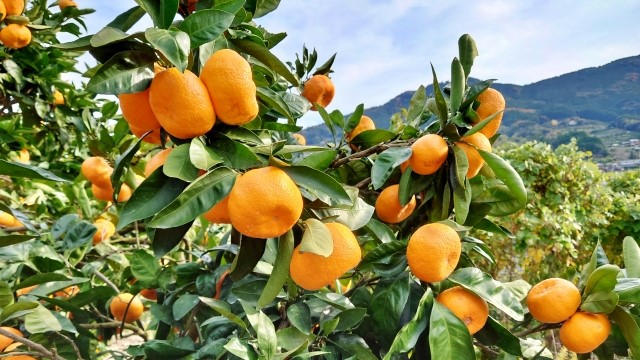
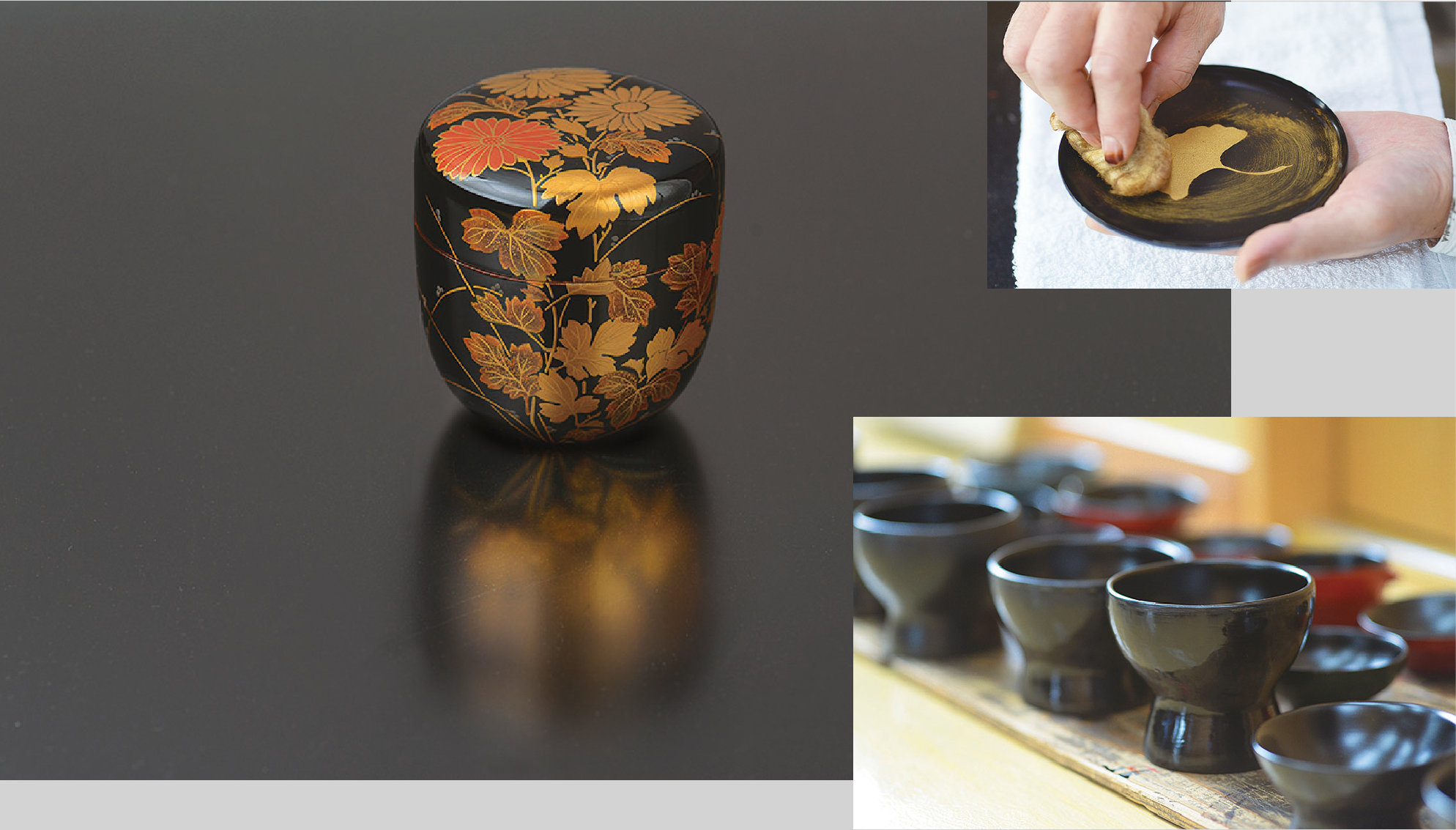
(Source: Wakayama Prefecture)

(Source: Wakayama Prefecture)
The Kishu Tokugawa Clan, a Cornerstone of the Tokugawa Shogunate and the Meiji Government

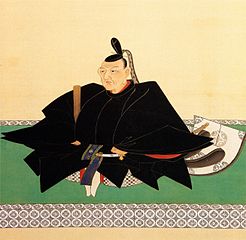
As time went by, Tokugawa Yoshimune (1684-1751, 徳川吉宗), the fifth lord of the Kishu domain and Yorinobu’s grandson, who held great respect for Yorinobu as a great lord, eventually assumed the eighth shogun within the Tokugawa Shogunate. In addition, the 13th Lord Iemochi (1846-1866, 徳川家茂) became the 14th shogun of the Tokugawa Shogunate. The Kishu Tokugawa family produced two shoguns, making it a key fiefdom in the Tokugawa Shogunate.

The Kishu domain, established by Yorinobu, continued to grow after the Meiji Restoration in 1868. Tokugawa Mochitsugu (1844-1906, 徳川茂承), the lord of the Kishu domain, implemented reforms in the system of personnel system based on the policy of equality for all individuals. He also encouraged the development of new industries and carried out a series of administrative reforms within the domain. In due course, the Meiji government, under the leadership of Emperor Meiji, would use the Kishu domain as a model case to build a modern nation. Notably, Ieyasu, Yorinobu, and the subsequent generations of Kishu domain lords contributed significantly to laying the groundwork for Japan's development.

(**) Source: https://commons.wikimedia.org/wiki/File
- Interviewed Takaaki Izumi (Curator, Wakayama Castle Maintenance and Planning Division)
Tokugawa Yorinobu Timeline
| Yorinobu | Ieyasu | Period | ||
| 1561 | Ieyasu made an alliance with Nobunaga | 20 | Warring State | |
| 1570 | Nobunaga & Ieyasu defeated the Asai and Asakura clans | 29 | ||
| 1582 | Nobunaga was killed at Honnoji by Akechi Mitsuhide | 41 | ||
| 1590 | Hideyoshi unified the nation | 49 | ||
| 1590 | Ieyasu moved to Edo according to Hideyoshi's order | 49 | ||
| 1598 | Hideyoshi passed away | 57 | ||
| 1600 | Tokugawa Ieyasu defeated Ishida Mitsunari, Hideyoshi's right arm at the battle of Sekigahara | 59 | ||
| 1602 | Tokugawa Yorinobu was born | Age=1 | - | |
| 1603 | Tokugawa Ieyasu established Tokugawa Shogunate at Edo | 2 | 62 | Edo |
| 1603 | Ieyasu built Nijojo Caslte | 2 | 62 | |
| 1605 | Tokugawa Hidetada became the 2nd Shogun of Tokugawa Shogunate | 4 | - | |
| 1612 | Ieyasu built Nagoya Caslte | 11 | 71 | |
| 1614 | The Winter Siege of Osaka. Yorinobu's first battle | 14 | 73 | |
| 1615 | Toyotomi's Osaka Castle burnt down to the ground at the Summer Siege of Osaka | 14 | 74 | |
| 1615 | Tokugawa Issued a set of regulations that applied to the emperor and the court nobles | 14 | 74 | |
| 1615 | Tokugawa Issued a set of various laws for warrior class families | 14 | 74 | |
| 1615 | Tokugawa Issued a set of various laws for temples | 14 | 74 | |
| 1616 | Ieyasu passed away at the age of 75 | 15 | 75 | |
| 1617 | The spirit of Ieyasu was enshrined at Nikko Toshogu Shrine | 16 | - | |
| 1619 | Tokugawa Yorinobu became the first lord of the Kishu domain | 18 | - | |
| 1621 | Yorinobu established Kishu Toshogu Shrine | 20 | - | |
| 1634 | Yorinobu promoted to sell Kishu orange in Edo city | 33 | - | |
| 1660 | Yorinobu issued Fubo-jo | 59 | - | |
| 1671 | Tokugawa Yorinobu passed away | 70 | - |
Recommendations to visit
Wakayama Castle
- Access: 1 hour from JR Shin-Osaka or JR Osaka Station on the Kuroshio, the limited express to JR Wakayama station. 6 minutes from JR Wakayama Station to Wakayama Castle by bus No. 0 or No. 25. Get off at Wakayama-jo-mae (和歌山城前) bus stop.
Kishu Toshogu Shrine
- Access: 25 minutes from JR Wakayama Station on Wakayama Bus. Get off at Gongen-mae (権現前) Bus Stop, then a 1-minute walk.

